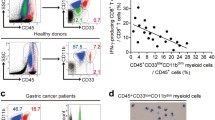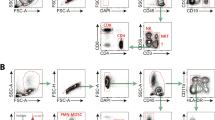Abstract
Background
Immune aberrations have been demonstrated in tumorogenesis, and myeloid-derived suppressor cells (MDSC) have shown to play a pivotal role in mediating immune suppression in animal models of human tumors. In the present study, we explored the clinical relevance of CD11b+/CD14−/CD15+/CD33+ MDSCs and the association of MDSCs with CD8+ cytotoxic T lymphocytes in patients with non-small-cell lung cancer (NSCLC).
Patients and methods
The population of CD11b+/CD14− cells in peripheral blood mononuclear cells (PBMNC) was determined in 173 patients with NSCLC and 42 control subjects. The expression of CD15, CD33, IL-4R, INF-γR, iNOS and l-arginase were analyzed. Cocultures with CD8+ T lymphocytes and Jurkat cells were developed to determine the impact of MDSCs on the expression of CD3ζ of CD8+ T lymphocytes.
Results
Patients with treatment-naïve, advanced-stage NSCLC (n = 87) had an increased subpopulation of CD11b+/CD14−/CD15+/CD33+ cells in the PBMNCs with characteristics of MDSCs (P < 0.0001). The CD11b+/CD14− cells in PBMNC also express IL-4R and INF-γR and can suppress CD3ζ expression in CD8+ T lymphocytes. The subpopulation of CD11b+/CD14− cells in PBMNC was decreased in the advanced-stage NSCLC patients who had responsiveness to chemotherapy (n = 41, P < 0.0001) and in the early-stage NSCLC patients after removal of tumor (n = 8, P = 0.0391). Notably, a negative association existed between the population of CD11b+/CD14− cells in PBMNC and the frequency of CD8+ T lymphocytes (n = 48, r = −0.3141, P = 0.0297).
Conclusions
Our study provided evidence of an increased pool of CD11b+/CD14−/CD15+/CD33+ MDSCs in the peripheral blood of NSCLC patients. For the suppressive effect of the cells on CD8+ T lymphocytes, these findings suggest the important role of the CD11b+/CD14−/CD15+/CD33+ MDSCs in mediating immunosuppression in NSCLC.





Similar content being viewed by others
References
Albina JE, Caldwell MD, Henry WL Jr, Mills CD (1989) Regulation of macrophage functions by l-arginine. J Exp Med 169:1021–1029
Almand B, Clark JI, Nikitina E, van Beynen J, English NR, Knight SC, Carbone DP, Gabrilovich DI (2001) Increased production of immature myeloid cells in cancer patients. A mechanism of immunosuppression in cancer. J Immunol 166:678–689
Beasley MB, Brambilla E, Travis WD (2005) The 2004 World Health Organization classification of lung tumors. Semin Roentgenol 40:90–97
Bosma GC, Custer RP, Bosma MJ (1983) A severe combined immunodeficiency mutation in the mouse. Nature 301:527–530
Bronte V, Serafini P, De Santo C, Marigo I, Tosello V, Mazzoni A, Segal DM, Staib C, Lowel M, Sutter G, Colombo MP, Zanovello P (2003) IL-4-induced arginase 1 suppresses alloreactive T cells in tumor-bearing mice. J Immunol 170:270–278
Bronte V, Kasic T, Gri G, Gallana K, Borsellino G, Marigo I, Battistini L, Iafrate M, Prayer-Galetti T, Pagano F, Viola A (2005) Boosting antitumor responses of T lymphocytes infiltrating human prostate cancers. J Exp Med 201:1257–1268
Buell JF, Gross TG, Woodle ES (2005) Malignancy after transplantation. Transplantation 80:S254–S264
Chen ML, Pittet MJ, Gorelik L, Flavell RA, Weissleder R, von Boehmer H, Khazaie K (2005) Regulatory T cells suppress tumor specific CD8 T cell cytotoxicity through TGF-β signals in vivo. Proc Natl Acad Sci USA 102:419–424
Curiel TJ, Coukos G, Zou L, Alvarez X, Cheng P, Mottram P, Evdemon-Hogan M, Conejo-Garcia JR, Zhang L, Burow M, Zhu Y, Wei S, Kryczek I, Daniel B, Gordon A, Myers L, Lackner A, Disis ML, Knutson KL, Chen L, Zou W (2004) Specific recruitment of regulatory T cells in ovarian carcinoma fosters immune privilege and predicts reduced survival. Nat Med 10:942–949
Danna EA, Sinha P, Gilbert M, Clements VK, Pulaski BA, Ostrand-Rosenberg S (2004) Surgical removal of primary tumor reverses tumor-induced immunosuppression despite the presence of metastatic disease. Cancer Res 64:2205–2211
Frey AB (2006) Myeloid suppressor cells regulate the adaptive immune response to cancer. J Clin Invest 116:2587–2590
Frey AB, Monu N (2006) Effector-phase tolerance: another mechanism of how cancer escapes antitumor immune response. J Leukoc Biol 79:652–662
Gabrilovich DI, Corak J, Ciernik IF, Kavanaugh D, Carbone DP (1997) Decreased antigen presentation by dendritic cells in patients with breast cancer. Clin Cancer Res 3:483–490
Gabrilovich DI, Velders M, Sotomayor E, Kast WM (2001) Mechanism of immune dysfunction in cancer mediated by immature Gr-1+ myeloid cells. J Immunol 166:5398–5406
Gallina G, Dolcetti L, Serafini P, De Santo C, Marigo I, Colombo MP, Basso G, Brombacher F, Borrello I, Zanovello P, Bicciato S, Bronte V (2006) Tumors induce a subset of inflammatory monocytes with immunosuppressive activity on CD8+ T cells. J Clin Invest 116:2777–2790
Huang B, Pan PY, Li Q, Sato AI, Levy DE, Bromberg J, Divino CM, Chen SH (2006) Gr-1+CD115+ immature myeloid suppressor cells mediate the development of tumor-induced T regulatory cells and T-cell anergy in tumor-bearing host. Cancer Res 66:1123–1131
Koneru M, Schaer D, Monu N, Ayala A, Frey AB (2005) Defective proximal TCR signaling inhibits CD8+ tumor-infiltrating lymphocyte lytic function. J Immunol 174:1830–1840
Koyama S, Koike N, Adachi S (2002) Expression of TNF-related apoptosis-inducing ligand (TRAIL) and its receptors in gastric carcinoma and tumor-infiltrating lymphocytes: a possible mechanism of immune evasion of the tumor. J Cancer Res Clin Oncol 128:73–79
Kusmartsev S, Nefedova Y, Yoder D, Gabrilovich DI (2004) Antigen-specific inhibition of CD8+ T cell response by immature myeloid cells in cancer is mediated by reactive oxygen species. J Immunol 172:989–999
Kusmartsev S, Nagaraj S, Gabrilovich DI (2005) Tumor-associated CD8+ T cell tolerance induced by bone marrow-derived immature myeloid cells. J Immunol 175:4583–4592
Mahnke YD, Speiser D, Luescher IF, Cerottini JC, Romero P (2005) Recent advances in tumor antigen-specific therapy: in vivo veritas. Int J Cancer 113:173–178
Monsurrò V, Wang E, Panelli MC, Nagorsen D, Jin P, Katia Z, Smith K, Ngalame Y, Even J, Marincola FM (2003) Active-specific immunization against melanoma: is the problem at the receiving end? Semin Cancer Biol 13:473–480
Monu N, Frey AB (2007) Suppression of proximal T cell receptor signaling and lytic function in CD8+ tumor-infiltrating T cells. Cancer Res 67:11447–11454
Munn DH, Mellor AL (2004) IDO and tolerance to tumors. Trends Mol Med 10:15–18
O’Connell J, Bennett MW, O’Sullivan GC, Collins JK, Shanahan F (1999) The Fas counterattack: cancer as a site of immune privilege. Immunol Today 20:46–52
Ochoa AC, Zea AH, Hernandez C, Rodriguez PC (2007) Arginase, prostaglandins, and myeloid-derived suppressor cells in renal cell carcinoma. Clin Cancer Res 13:S721–S726
Penn I (1986) Cancer is a complication of severe immunosuppression. Surg Gynecol Obstet 162:603–610
Pittet MJ, Zippelius A, Speiser DE, Assenmacher M, Guillaume P, Valmori D, Liénard D, Lejeune F, Cerottini JC, Romero P (2001) Ex vivo IFN-γ secretion by circulating CD8 T lymphocytes: implications of a novel approach for T cell monitoring in infectious and malignant diseases. J Immunol 166:7634–7640
Rabinovich GA, Gabrilovich D, Sotomayor EM (2007) Immunosuppressive strategies that are mediated by tumor cells. Annu Rev Immunol 25:267–296
Radoja S, Saio M, Schaer D, Koneru M, Vukmanovic S, Frey AB (2001) CD8(+) tumor-infiltrating T cells are deficient in perforin-mediated cytolytic activity due to defective microtubule-organizing center mobilization and lytic granule exocytosis. J Immunol 167:5042–5051
Rodriguez PC, Quiceno DG, Zabaleta J, Ortiz B, Zea AH, Piazuelo MB, Delgado A, Correa P, Brayer J, Sotomayor EM, Antonia S, Ochoa JB, Ochoa AC (2004) Arginase I production in the tumor microenvironment by mature myeloid cells inhibits T-cell receptor expression and antigen-specific T-cell responses. Cancer Res 64:5839–5849
Rodriguez PC, Hernandez CP, Quiceno D, Dubinett SM, Zabaleta J, Ochoa JB, Gilbert J, Ochoa AC (2005) Arginase I in myeloid suppressor cells is induced by COX-2 in lung carcinoma. J Exp Med 202:931–939
Rosenberg SA, Dudley ME (2004) Cancer regression in patients with metastatic melanoma after the transfer of autologous antitumor lymphocytes. Proc Natl Acad Sci USA 101:14639–14645
Rosenberg SA, Sherry RM, Morton KE, Scharfman WJ, Yang JC, Topalian SL, Royal RE, Kammula U, Restifo NP, Hughes MS, Schwartzentruber D, Berman DM, Schwarz SL, Ngo LT, Mavroukakis SA, White DE, Steinberg SM (2005) Tumor progression can occur despite the induction of very high levels of self/tumor antigen-specific CD8+ T cells in patients with melanoma. J Immunol 175:6169–6176
Schmielau J, Finn OJ (2001) Activated granulocytes and granulocyte-derived hydrogen peroxide are the underlying mechanism of suppression of T-cell function in advanced cancer patients. Cancer Res 61:4756–4760
Schmielau J, Nalesnik MA, Finn OJ (2001) Suppressed T-cell receptor zeta chain expression and cytokine production in pancreatic cancer patients. Clin Cancer Res 7(3 Suppl):S933–S939
Serafini P, De Santo C, Marigo I, Cingarlini S, Dolcetti L, Gallina G, Zanovello P, Bronte V (2004) Derangement of immune responses by myeloid suppressor cells. Cancer Immunol Immunother 53:64–72
Shankaran V, Ikeda H, Bruce AT, White JM, Swanson PE, Old LJ, Schreiber RD (2001) INFgamma and lymphocytes prevent primary tumour development and shape tumour immunogenicity. Nature 410:1107–1111
Shimizu J, Yamazaki S, Sakaguchi S (1999) Induction of tumor immunity by removing CD25+ CD4+ T cells: a common basis between tumor immunity and autoimmunity. J Immunol 163:5211–5218
Speiser DE, Colonna M, Ayyoub M, Cella M, Pittet MJ, Batard P, Valmori D, Guillaume P, Liénard D, Cerottini JC, Romero P (2001) The activatory receptor 2B4 is expressed in vivo by human CD8+ effector αβ T cells. J Immunol 167:6165–6170
Street SE, Trapani JA, MacGregor D, Smyth MJ (2002) Suppression of lymphoma and epithelial malignancies effected by interferon gamma. J Exp Med 196:129–134
Swann JB, Smyth MJ (2007) Immune surveillance of tumors. J Clin Invest 117:1137–1146
Tas MP, Simons PJ, Balm FJ, Drexhage HA (1993) Depressed monocyte polarization and clustering of dendritic cells in patients with head and neck cancer: in vitro restoration of this immunosuppression by thymic hormones. Cancer Immunol Immunother 36:108–114
Uyttenhove C, Pilotte L, Théate I, Stroobant V, Colau D, Parmentier N, Boon T, Van den Eynde BJ (2003) Evidence for a tumoral immune resistance mechanism based on tryptophan degradation by indoleamine 2, 3-dioxygenase. Nat Med 9:1269–1274
Woo EY, Yeh H, Chu CS, Schlienger K, Carroll RG, Riley JL, Kaiser LR, June CH (2002) Cutting edge: regulatory T cells from lung cancer patients directly inhibit autologous T cell proliferation. J Immunol 168:4272–4276
Zea AH, Rodriguez PC, Atkins MB, Hernandez C, Signoretti S, Zabaleta J, McDermott D, Quiceno D, Youmans A, O’Neill A, Mier J, Ochoa AC (2005) Arginase-producing myeloid suppressor cells in renal cell carcinoma patients: a mechanism of tumor evasion. Cancer Res 65:3044–3048
Zou W (2005) Immunosuppressive networks in the tumor environment and their therapeutic relevance. Nat Rev Cancer 5:263–274
Acknowledgments
The authors would like to thank Ms. Ya-Ling Chang and Ms. Chih-Chen Ho in the Department of Thoracic Medicine of the Chang-Gung Memorial Hospital for assisting with the flow cytometric study. This work was funded by the National Science Council of Taiwan (NSC 97-2314-B-182A-091-MY2) and the Chang-Gung Memorial Hospital (CMRPG-371651 and CMRPG-376373).
Conflict of interest statement
The authors indicated no potential conflicts of interest.
Author information
Authors and Affiliations
Corresponding authors
Additional information
C.-Y. Liu, Y.-M. Wang, and C.-L. Wang contributed equally to the work on this project as first authors.
Rights and permissions
About this article
Cite this article
Liu, CY., Wang, YM., Wang, CL. et al. Population alterations of l-arginase- and inducible nitric oxide synthase-expressed CD11b+/CD14−/CD15+/CD33+ myeloid-derived suppressor cells and CD8+ T lymphocytes in patients with advanced-stage non-small cell lung cancer. J Cancer Res Clin Oncol 136, 35–45 (2010). https://doi.org/10.1007/s00432-009-0634-0
Received:
Accepted:
Published:
Issue Date:
DOI: https://doi.org/10.1007/s00432-009-0634-0




